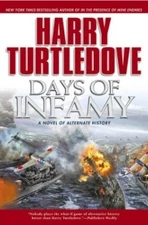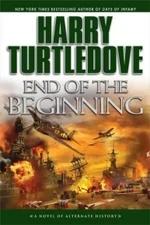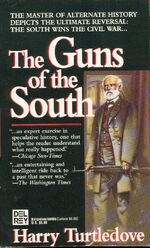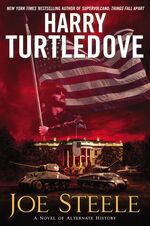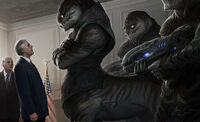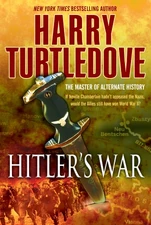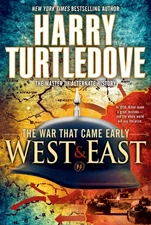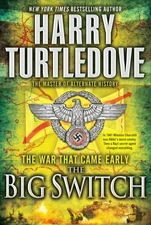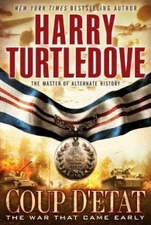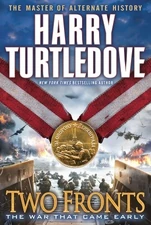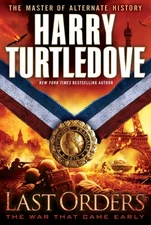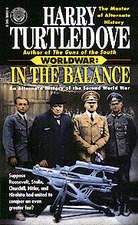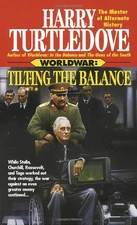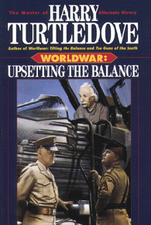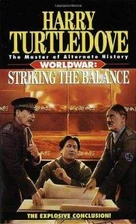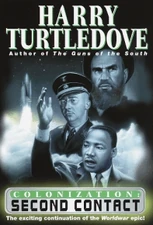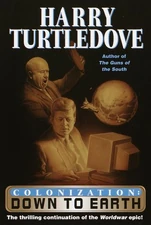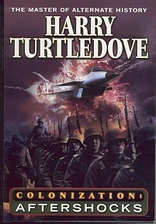
The United States Army is the ground defense force of the United States. It is the largest and oldest established branch of the U.S. military.
United States Army in Days of Infamy
The divisions of the US Army stationed in Hawaii were completely unprepared for the surprise Japanese invasion of the Hawaiian islands. Army Air Corps fighter planes were destroyed on the runways during the initial attack, leaving American personnel vulnerable targets to Japanese planes. This was especially seen when Army columns at the Kamehameha Highway that were being sent to defend northern Oahu from Japanese landing forces were severely strafed by Japanese planes.
Despite these setbacks, the Army made their best efforts to defend Hawaii. The Army was aided by Navy personnel, whose service at the naval station at Pearl Harbor was rendered moot after the battleships at Pearl Harbor were crippled during the attack. The Army surrendered once Hawaii was conquered in February, 1942. In the process, American servicemen became POWs and were cruelly subjected to the Japanese Army's brutal policy towards prisoners.
During and after the US recapture of Hawaii, the surviving POWs were liberated.
United States Army in The Guns of the South
The United States Army, referred to commonly as the Federal Army or Union Army at the time, was involved in what came to be known as the Second American Revolution against the Confederate States Army. By the winter of 1864, the Federal Army's strength far exceeded that of its enemy and it held large swaths of Confederate territory. With several changes in leadership, the Army intended to launch its final offensive to crush the Confederacy come spring.
Throughout the last months of winter, US Cavalry staged several raids into Confederate territory. However, these raids were repulsed with heavy casualties and in some instances complete annihilation. In some instances, the Confederacy had advanced warning of these attacks.
When spring came, the Union Army marched with the intention of defeating the Confederates. However, armed with a new repeating rifle, the Confederate Army counter-attacked and pushed back the Union forces on all fronts. In just several days, the Union Army lost over 60,000 men, including 40,000 at the Battles of the Wilderness and Bealeton, and had its supply lies severed by Confederate Cavalry.
The Union forces in the east retreated for Washington City which soon came under siege by Confederate forces. Despite heavy fortifications, the Confederate Army broke through and reached the White House, bringing about a cease-fire that eventually ended the war.
Like the Confederate Army, the US Army was posted along the shared border in case hostilities broke out again.
In the years following the end of the Revolution, Union inventors were able to reverse-engineer the AK-47 and provide Federal troops with new variants of the repeater. Armed with these weapons, they invaded and conquered the Canadas across their northern border.
United States Army in Joe Steele
After United States Army captain Roland Laurence South attempted to assassinate President Joe Steele in March 1937, Steele ordered the newly created Government Bureau of Investigation to look into the U.S. military overall.[1] In short order, the military was purged of wreckers, and a U.S. Army more loyal to Steele emerged.[2] Happily for the U.S., some talented generals, such as George Marshall, Dwight Eisenhower, and Omar Bradley were spared, and thus helped steer the country through World War II and the Japanese War.
During World War II, the Army made use of "punishment brigades", made up of convicted wreckers who wanted to rehabilitate themselves. These brigades were sent into the most dangerous situations.[3]
United States Army in "The Road Not Taken"
The United States Army reintroduced conscription in the 2030s after the Second Syrian Crisis.
United States Army in Southern Victory
1861-1914
The United States Army failed to cover itself with glory during the latter half of the 19th Century; losing both the War of Secession and the Second Mexican War to the breakaway Confederate States and its European allies. Its defeat in both conflicts was a combination of overstretch (due to the lack of prewar preparations) and the incompetence of its generals. With a lack of prepared plans, the general strategy of the US Army in both wars was to overwhelm the Confederate States with sheer numbers. Unfortunately, when facing the likes of Robert E. Lee, Stonewall Jackson, and Jeb Stuart, sheer numbers were not enough. The superior numbers of the US Army were squandered in fruitless actions.
In addition, the US Army suffered from morale problems, especially after the stunning defeat at the Battle of Camp Hill. When the common soldier felt that his leaders did not have his best interests in mind, the common soldier fought poorly. In all probability, desertions were high in the Army of the Potomac after Camp Hill, which led to the conquest of Philadelphia.
The Great War (1914-17)
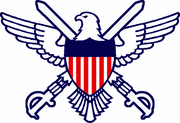
The US Army's Eagle with Crossed Swords device, used to identify all vehicles and aircraft
After its defeat in 1882, the United States entered into the age of Remembrance, and sought to learn new lessons from the forces of Germany, who had been victorious during the Franco-Prussian War. They adopted the German field-grey uniform, recoloring it green-grey, along with German standards of discipline. By the outbreak of the Great War in 1914, the US Army consisted of a massive force of regular soldiers. In addition, when the Great War broke out, there were large numbers of trained soldiers that were recalled thanks to conscription. Conscription enabled the United States to draw on their larger population and easily sustain a two-front war against the CSA and Canada. Despite the heavy losses suffered due to the nature of trench warfare and the cavalier attitude of certain generals such as George Armstrong Custer, the US Army was able to retake ground lost early in the war, drive the Confederates from Kentucky, Houston, Sequoyah , and some border chunks, and seize the vital areas of Canada. By the end of the war in 1917, the US Army was the unchallenged military force in North America.
During the war US soldiers wore green-gray uniforms based on the German feldgrau model, and adopted 'coalscuttle' helmets during 1915. The bolt-action M1903 Springfield rifle was the standard personal weapon, with flamethrowers, hand grenades, light machine guns, poison gas, and barrels being introduced during the war. In addition, the US Army had an advantage in heavy artillery, which was somewhat offset by the fast-firing "French 75" howitzer used by the CSA.
The Interwar Years (1917-41)
The Socialist presidencies of the 1920s saw the US Army gutted by funding cuts, barely leaving enough men to garrison Utah and Canada and patrol the CS border. Research and development into barrels was slashed, to the point where US barrel forces lost any possible leads over their CS counterparts.
The Pacific War and the presidency of Herbert Hoover saw some funding restored to the armed forces. With Jake Featherston preaching fire and hate in the CS, Al Smith continued to quietly prepare the US Army for a new war, including the much-delayed mass production of Mk II barrels. Alas, US strategy lagged behind technology, and the General Staff believed that the new war would be a repeat of the last.
The Second Great War (1941-44)
From the opening shots of Operation Blackbeard, the US Army was caught badly out of position, and its CS counterparts easily cut through to Lake Erie during the summer of 1941 despite the former's fierce resistance. An offensive into northern Virginia under General Daniel MacArthur initially gained ground but soon bogged down, resulting in massive casualties. As if this wasn't enough, Utah erupted in violence following the success of Blackbeard, diverting more US soldiers out west.
The Ohio front would be a stalemate until the summer of 1942 with Operation Coalscuttle; the Confederate drive on Pittsburgh. America's abysmal record would improve throughout the latter half of the year. Now under the command of the aggressive Brigadier General Irving Morrell, the Americans, while failing to prevent the Confederates from reaching Pittsburgh, forced them to push into the city itself, where they were annihilated in the wars' decisive battle. At the same time, the growing US Army mounted smaller offensives into Arkansas and west Texas, while keeping the pressure up in north Virginia. Individually, these offensives accomplished little; together they tied down possible CS reinforcements.
During 1943 US soldiers cleaned up the final CS pockets in Pittsburgh, forced a cease-fire in Utah, and contained the Canadian rebellion (which had erupted in the wake of Coalscuttle). Not only did they drive the Confederates from Ohio, but they succeeded, in a mere six months, in taking Kentucky, Houston, Tennessee, and northern Georgia. By New Year's Day, the Americans had taken Atlanta, the key Confederate transportation hub in the east.
In 1944, the United States effectively dominated the Confederate States, driving deep into CS territory and crushing any and all opposition. With the deployment of superbombs by both sides and the death of Jake Featherston, the CS was defeated and occupied in its entirety by the US Army.
During this war the American uniform and small arms were unchanged from the last conflict; the Springfield proved an inferior weapon to the submachine guns and automatic rifles of Confederacy. Because of the War Department's tardiness in manufacturing automatic weapons for its own soldiers, US troops took to wielding captured Confederate automatic weapons. Later in the war, US soldiers began to receive the M1 Thompson submachine gun "big, brutal, and Made in the USA," sometime in late 1943.
Artillery remained mostly unchanged, with 105mm howitzers replacing the lower-caliber 75mm howitzers that had been standard divisional field artillery during the last war. In addition, the superiority in heavy artillery probably continued during the Second Great War.
American barrel crews proved the equal of their CS counterparts, despite their inferior barrels. When provided with barrels (upgraded Mark II's) that were a match for those used by the Confederate Army, they proved to be formidable foes. In 1943, the new Mark III barrel began to be distributed to front-line barrel units in time for the drive to Atlanta. The Mark III was superior to any Confederate barrel, giving US Barrel forces a distinct advantage. This was seen in the fighting for Kentucky and Tennessee.
United States Army in "Vilcabamba"
After the Krolp invaded, the United States Army was a shadow of its former self, having been defeated during the initial invasion, and then the unified uprising in which Russia and China joined the rump United States/Canada in a failed attempt to defeat the Krolp. By the time the Krolp embassy led by Prilk arrived, the U.S. Army had a few working tanks, substantial firearms, and even several dozen Krolp weapons. When the U.S. elected to fight the Krolp rather than let the Krolp strip-mine in U.S. territory, the U.S. Army was completely defeated by the Krolp, and the U.S. officially ceased to exist.
United States Army in The War That Came Early
The United States Army entered World War II in January 1941, when Japan invaded the Philippines. US Army garrisons on Wake Island and Guam were quickly over run, while the US Army in the Dutch East Indies was unable to prevent the Japanese from cutting the islands in two.
United States Army in Worldwar
The United States Army was surprised by the Race's invasion in 1942. Prior to the invasion, the US Army had been building up for the fight overseas. By the time the Race invaded, the US had produced a large number of vehicles and small arms for intended battle against the German Wehrmacht and Imperial Japanese Army.
Standard infantry weapons of the US Army consisted of the M1 Garand semi-automatic rifle, the M1903 Springfield bolt-action rifle, M1 Carbine, Thompson submachine gun, BAR, M1919 .30 caliber machine gun's, and the Browning M2HB heavy machine gun.
Armor of the US Army consisted of M3 Stuart light tanks, along with M3 Lee and M4 Sherman medium tanks in small numbers. During the initial invasion, the Army sustained heavy losses of men and materiel to the superior weapons of the Race. The US Army was forced to conscript thousands of civilians and was largely reduced to an infantry force, saving its tanks and aircraft for only the most dire situations or for rare offensive operations.
Resistance initially collapsed everywhere west of the Mississippi River. US cavalry, an outdated force by modern standards, became a crucial tool in raiding Race positions to undermine their efforts. Perhaps due to its geography, the US Army held a stable presence in Florida. The remnants of the Army were then deployed to protect Chicago, which the Race sought to capture due to its status as a transportation and manufacturing hub. Unknown to many, it was also the original home to the US effort to develop atomic weapons.
Despite suffering heavy losses, the US Army held the Race back until the winter of 1942 set in, effectively paralyzing the Race offensive. Under the leadership of Omar Bradley and the hard-charging George Patton, the US rallied its forces and counter-attacked. Though suffering heavy losses, they pushed the Race back and destroyed a large number of troops. As 1943 began, the Race renewed their attacks, and both sides suffered huge losses in house to house fighting. The US Army retreated from Chicago eventually, but not before planting an the Fat Lady bomb to destroy the Race forces once they moved in. The Battle of Chicago ended inconclusively for both sides.
The primary conflict in North America moved to Colorado, where the Race made Denver their next target. Unknown to them, this was the center for America's research into atomic weapons. The US Army dug in to protect the city with a massive line of trenches, tank traps, and other defenses. The Battle of Denver was just as bloody as Chicago, but the line was held. And just like Chicago, the battle ended when US forces used a planted atomic bomb to decimate a Race offensive.
It was around this time that the Race, growing less conservative in their tactics, deployed their own atomics in Florida and destroyed the US front there. Despite this victory, the failure to capture Chicago and Denver, along with near constant attacks on the Race's occupation forces throughout the country, made the Race give up their attempts to conquer the US.
| |||||||||||||||||
| |||||||||||||||||||
| |||||||||||||||||||
| |||||||||||
| |||||||||||||
| ||||||||||||||||||||||
| |||||||||||||||||||||||||
- ↑ Joe Steele, pg. 153, HC.
- ↑ Ibid., pg. 153.
- ↑ Ibid., pgs. 263-265.
